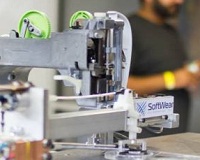"Technology and automation has taken over manual work in the garment industry these days. From harvesting cotton in the farms, to making thread, then weaving it into cloth in looms, followed by the stage of printing, the textile manufacturing cycle has largely been automated in the past two hundred years. Softwear Automation, a company based in Atlanta, US, has built an entire assembly line manned by robots that can pick a piece of garment, arrange it properly and then sew it. This technology is called the sewbot. While picking up a piece of fabric by a robot used to be a big achievement, today it can perform almost each and every task."

Technology and automation has taken over manual work in the garment industry these days. From harvesting cotton in the farms, to making thread, then weaving it into cloth in looms, followed by the stage of printing, the textile manufacturing cycle has largely been automated in the past two hundred years. Softwear Automation, a company based in Atlanta, US, has built an entire assembly line manned by robots that can pick a piece of garment, arrange it properly and then sew it. This technology is called the sewbot. While picking up a piece of fabric by a robot used to be a big achievement, today it can perform almost each and every task.

It is a combination of powerful algorithms, fast computing speed and the ever-decreasing cost of technological products. The sewbot work-line robots rely on high speed cameras, which see the individual threads in fabric, pinpointing the exact location where a needle strikes and adjusting the garment accordingly. Softwear Automation believes that this as a disruptive technology, which will have a lasting impact on how apparel, home textiles and garments are made. And it can do that without workers. Palaniswamy Rajan, CEO, Softwear Automation, says its sewbot work-line can produce nearly twice as many finished T-shirts in an eight-hour shift as manual sewing and can running 24 hours a day. It’s 80 per cent more efficient.
Growth momentum
Growth in industrial robot sales is led by Asia. Between 2011 and 2016, robot sales increased on 12 per cent an average. Apart from Softwear Automation, sewbot is also bringing in dynamics shift in the way garments are being manufactured these days. Jon Zornow, founder, sewbo, devised a method to stiffen fabric by using a dissolvable chemical solution. This allows cardboard-like hard patches of material such as denim to be handled by robots. Once sewed, the garment is washed with water without compromising its quality. Zornow’s inspirations stem from 3D printing. The technology also uses water-soluable scaffolding to temporarily support objects as they are being created on the 3D printer. His robots come off the shelf, making it easier for companies to find replacements when needed.
Bringing manufacturing back to the US
Big retailers such as Walmart, which source garments and apparel from developing countries, have to wait months before they can put a new line clothes on the shelf. This is because clothing samples are sent back and forth for approval. Softwear Automation has received funding from Walmart as the retail giant wants to meet demand before fashion wears out. Both Rajan and Zornow are focusing primarily on the US market for their robots. They see a timeline of at least five years for the technology to start making any marked change. Rajan informed that a brand or manufacturer that’s willing to commit can have up to 10 per cent of its manufacturing to the US within five years of setting up a Sewbot factory. However, sewbots are not meant to replace all garment manufacturing. Using automation for high-volume basic apparel enables sewing machine workers to focus more on complex garments, while advancing their skill sets and commanding higher wages all around the world. The shift to e-commerce and on-demand manufacturing makes this even more important.












